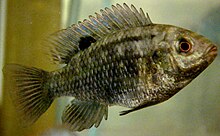Tilapiine cichlid
| Tilapiine cichlids | |
|---|---|

| |
| Tilapia sparrmanii | |
| Scientific classification | |
| Domain: | Eukaryota |
| Kingdom: | Animalia |
| Phylum: | Chordata |
| Class: | Actinopterygii |
| Order: | Cichliformes |
| Family: | Cichlidae |
| Subfamily: | Pseudocrenilabrinae |
| Tribe: | Tilapiini |
| Genera[1] | |
| |
| Synonyms | |
|
Tilapiinae | |
TheTilapiini(occasionally Tilapini) are atribewithin the familyCichlidaecommonly known astilapiine cichlids.Formerly this tribe contained many othergeneraand species, including the economically importantOreochromisandSarotherodon,but ataxonomicreview found that this grouping wasparaphyleticand most were moved toCoelotilapini,Coptodonini,Heterotilapini,OreochrominiandPelmatolapiini.Together, most species in these tribes are called "tilapias".In a more distant past, a number of other, more different genera likeSteatocranusalso were included in Tilapiini. With these as separate, Tilapiini now is a much more restricted tribe with only three genera and about half a dozen species fromCentralandSouthern Africa.[1][2][3]
Systematics[edit]
The tilapiines were recognised by theichthyologistEthylwynn Trewavas.[1]
mtDNA-basedphylogeniesof tilapiines must be evaluated with caution, however, as they are usually close to, but do not represent the true evolutionary relationships of these fishes. The reason is thathybridizationwithin any one of these major lineages is known to usually produce fertile offspring, and might[4]also do so between the lineages.Gene poolsin these fishes have been kept (largely) separate by behavioral cues for millions of years, but reproductive incompatibility has been far slower to evolve, like in manyPseudocrenilabrinae(African cichlids).[5]
A smallsample size—one to a mere handful of specimens pertaxon—as is often used in molecular studies further acerbates the problem. As discussed below for the example ofmouthbreeding,nonmolecular data such asmorphologyorbehaviorhave also turned out to be extremely prone tohomoplasies,not the least due to the small but ongoinggene flowbetween evolutionarily quite distant gene pools.
Essentially, most traditional and mtDNA-based phylogenetic hypothesis for tilapiines must be considered with a high degree of caution. This problem could be alleviated to some extent by usingnDNAsequences. Comparing these with the mtDNA data, hybridization effects could be discerned. Also, resolution of nDNA likely is still good enough to delimit thecladesthat apparently exist in the "tilapiines" if numerous taxa and specimens are sampled. Researchers could then reanalyze morphological data to discover actualautapomorphies.
Evolution seems to run quickly in this group. Even the fast-evolving mtDNA sequences often are incapable of properly resolving interspecies relationships.[6]The precise evolutionary history of some tilapiines may not be properly resolved with presently available methods, for the reasons discussed above.
Diversity of breeding behaviour[edit]
Like other cichlids, tilapiines exhibit complex reproductive behaviours and guard their eggs and fry. Broadly speaking, theplesiomorphictrait is substratum-spawning behavior, meaning that the fish form pairs, lay the eggs on a rock or into a depression made in the substrate, and then both parents guard the eggs and fry.
References[edit]
- ^ab"Pseudocrenilabrinae".NCBI.Retrieved27 September2019.
- ^Naglet al.(2001), Klett & Meyer (2002)
- ^Andreas R.Dunz & Ulrich K.Schliewen (2013). "Molecular phylogeny and revised classification of the haplotilapiine cichlid fishes formerly referred to asTilapia".Molecular Phylogenetics and Evolution.68(1): 64–80.doi:10.1016/j.ympev.2013.03.015.PMID23542002.
- ^LI Si-Fa; ZHAO Yan; FAN Wu-Jiang; CAI Wan-Qi; XU Ying-Fang (October 2011)."Possible genetic reproductive isolation between two tilapiine genera and species: Oreochromis niloticus and Sarotherodon melanotheron".Bioline.
- ^Naglet al.(2001)
- ^Compare support values and proposed relationships in Naglet al.(2001) to Klett & Meyer (2002)
Further reading[edit]
- Klett, Vera & Meyer, Axel (2002): What, if Anything, is a Tilapia? Mitochondrial ND2 Phylogeny of Tilapiines and the Evolution of Parental Care Systems in the African Cichlid Fishes.Molecular Biology and Evolution19(6): 865–883.
- Nagl, Sandra; Tichy, Herbert; Mayer, Werner E.; Samonte, Irene E.; McAndrew, Brendan J. & Klein, Jan (2001): Classification and Phylogenetic Relationships of African Tilapiine Fishes Inferred from Mitochondrial DNA Sequences.Molecular Phylogenetics and Evolution20(3): 361–374.doi:10.1006/mpev.2001.0979
- Trewavas, Ethelwynn (1983):Tilapiine fishes of the generaSarotherodon,OreochromisandDanakilia. Published by the British Museum (Natural History), London. 583 pages.ISBN0-565-00878-1
